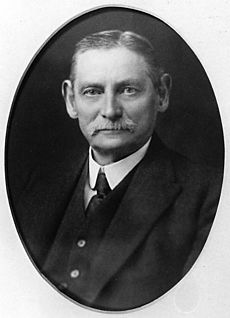Matthew Henry Phineas Riall Sankey facts for kids
Matthew Henry Phineas Riall Sankey (born November 9, 1853 – died October 3, 1925) was an engineer from Irish. He was also a captain in the Royal Engineers, a special part of the British Army. He is most famous for creating something called the Sankey diagram. This is a special type of picture that shows how energy or materials flow.
Contents
Who Was Matthew Sankey?
Matthew Sankey was born in 1853 in a place called Nenagh, in County Tipperary, Ireland. His father was General William Sankey. Matthew first went to school in Switzerland. Later, he studied at the Royal Military Academy and the Royal School of Military Engineering in England. He married Elisabeth Pym in 1876.
Early Career and Military Work
While still studying, Sankey worked as a research assistant. He helped with a big study on railway accidents. He did calculations and experiments on train brakes. After finishing his studies, he joined the British Army. He worked on architectural designs for the War Office. He also led a team of 16 draughtsmen (people who draw technical plans) in Manchester.
Later, he went to Gibraltar. There, he oversaw the building of army barracks for a telegraph station. From 1879 to 1882, he taught at the Royal Military College of Canada. Then he returned to England. He worked for the Ordnance Survey, which makes maps.
Engineering and Business
From 1889 to 1904, Sankey was a director at a company called Willans & Robinson. They were engineers. In 1892, he became their lead engineer. He designed steam engines. He also planned their new factory in Rugby.
After that, from 1904 to 1909, he worked as a consultant. He advised companies on steam and internal-combustion engines. From 1909 until he passed away in 1925, he was on the board of Marconi's Wireless Telegraph Company. He also served on the boards of other companies.
World War I Service
During World War I, Sankey volunteered to help. He worked as a staff officer. He was part of the department that handled fortifications and building projects. For his service in the war, he received two important awards: the Order of the Bath (CB) and the Order of the British Empire (CBE). He was also the President of the Institution of Mechanical Engineers.
Matthew Sankey's Work
The Sankey Diagram
In 1898, Matthew Sankey wrote an article. It was about how efficiently a steam engine used energy. In this article, he showed the first energy flow diagram. This special picture was later named the Sankey diagram.
Sankey explained how to understand his diagram:
- No part of a steam plant is perfect.
- Each part loses some energy.
- To make the plant better, you need to know where these losses happen.
- The diagram helps you see these losses clearly.
- Rectangles on the diagram show different parts of the plant. These include the boiler, engine, and condenser.
- The flow of heat is shown like a stream. The wider the stream, the more heat is flowing.
- Losses are shown as smaller "waste branches" coming off the main stream.
- A very important (but small) branch shows the useful work done by the engine.
The idea of a flow diagram was first used by Charles Joseph Minard. He used it to show the number of Napoleon's soldiers during the Russian campaign of 1812. Sankey took this idea and used it for energy flow. His diagram made a big impression. Other engineers, like Robert Henry Thurston, later agreed that the Sankey Diagram was the best way to show how heat was used in modern steam engines.
Inventions and Patents
Matthew Sankey also received several patents for his inventions. A patent is a special right given to an inventor. It means only they can make, use, or sell their invention for a certain time. Sankey received patents for:
- An expansion-gear for engines (1894)
- A turbine (1905)
- A reversible turbine (1907)
- A steam-turbine (1907)



